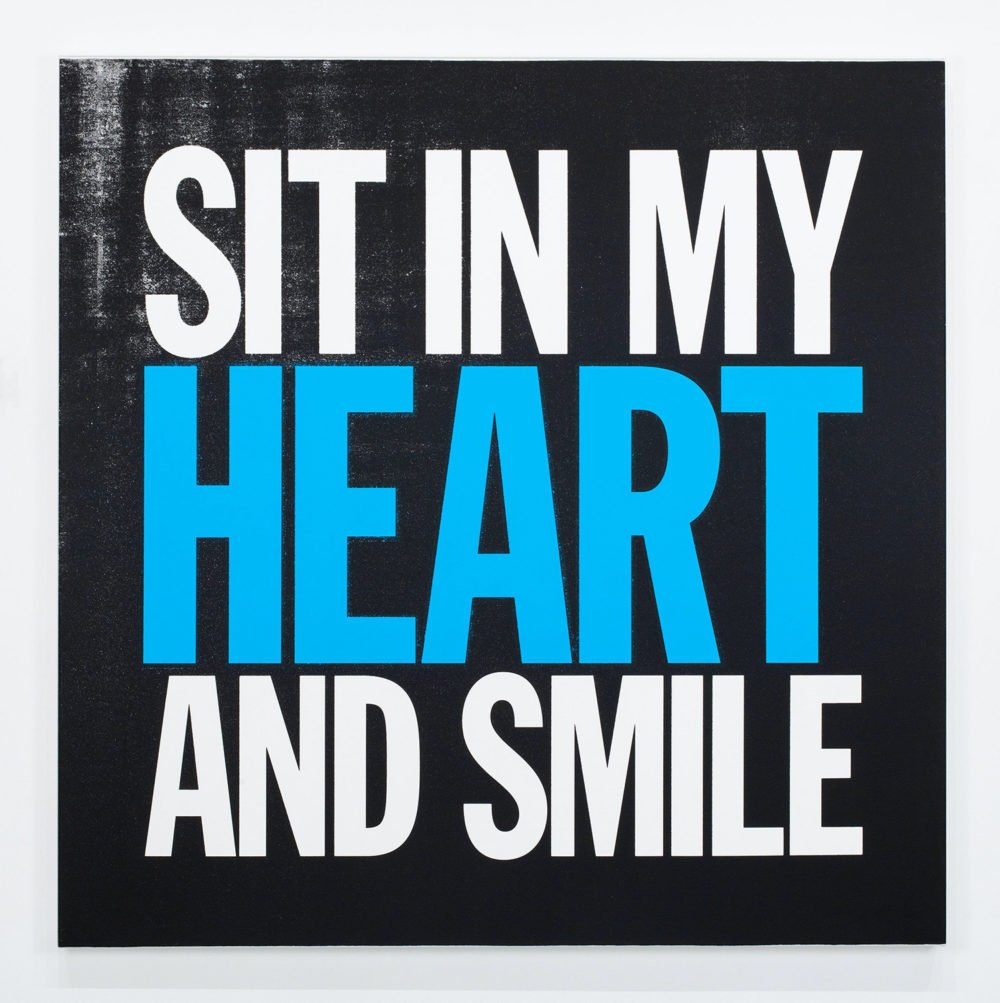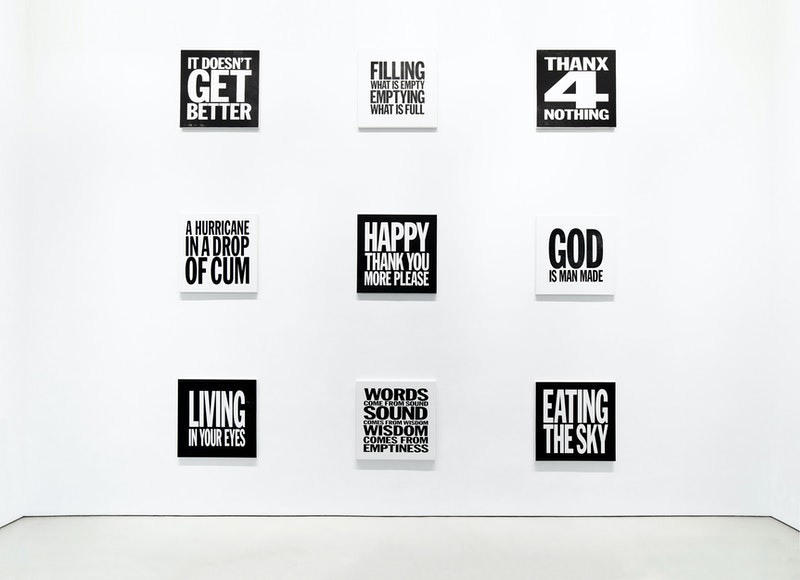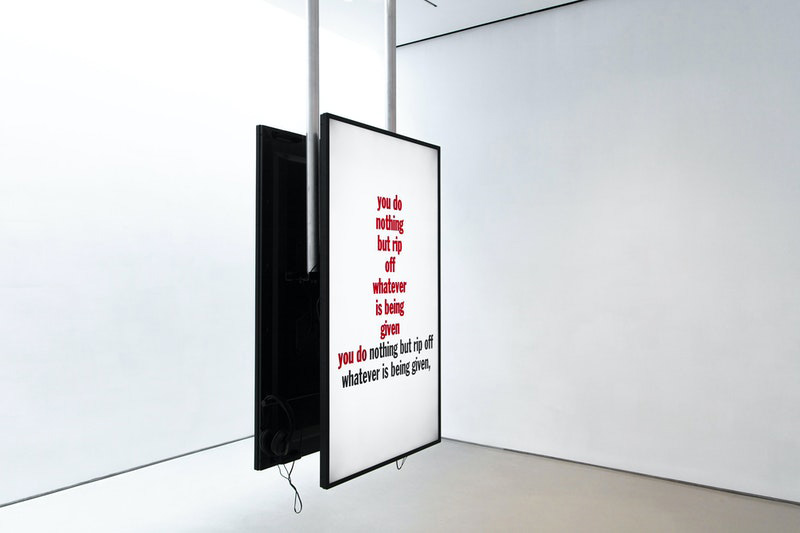
- Source: The Brooklyn Rail
- Author: Barbara A. MacAdam
- Date: May 25, 2021
- Format: Digital
John Giorno
Review: SIT IN MY HEART AND SMILE

John Giorno, SIT IN MY HEART AND SMILE, 2017. Silkscreen, acrylic on canvas, 48 x 48 inches. Courtesy Sperone Westwater, New York.
The announcement for this deep, mystifying, mesmerizing, and witty presentation of word paintings (2011–2018), all silkscreen and acrylic on canvases measuring 48 by 48 inches, features the work SIT IN MY HEART AND SMILE (2017). Installed in a grid on the gallery’s main floor is a series of 12 black-and-white paintings—insistent, concentrated incantations and verbal outbursts set in a trademark font designed by Mark Michaelson in 1984. On the second floor of the gallery are four separate works in color.
“Art” is most certainly the center of HEART, and it’s Giorno’s own form of Buddhism, expressed in his distinctive visual language. (He was devout but exceptional.) The words are the embodiment of compression—the equivalent of the Buddhist mantra “Om” designed to empty the head, or, in Giorno’s, case, to fill it.

Installation view: John Giorno, Sperone Westwater, New York, 2020. Courtesy Sperone Westwater, New York.
The phrases range from the dead-pan and cliched utterances like “IT DOESN’T GET BETTER” to “THANX 4 NOTHING,” “HAPPY THANK YOU MORE PLEASE,” and “WORDS COME FROM SOUND SOUND COMES FROM WISDOM WISDOM COMES FROM EMPTINESS” to “A HURRICANE IN A DROP OF CUM,” and the definitive “GOD IS MAN MADE.” Each seemingly simple utterance requires concentration and unpacking. As concrete poetry, the meaning and sound differ with each reading, though the visual representation remains constant.
Influenced by Warhol, Rauschenberg, the graphic art of Pop as Edward Ruscha construed it, and the shock and schlock of advertising slogans and other signage, Giorno mixed media to promulgate feelings, beliefs, and social justice. The poet, who died in 2019 at 82, gave readings with his many cohorts, ranging from Jasper Johns to Frank O’Hara to John Cage, starred in his then-lover Andy Warhol’s 1964 legendary film Sleep, and was an inventor of Dial-A-Poem, still operating with that basic, now nearly defunct beloved form of technology (call 641-793-8122).
Reviewing Giorno’s memoir in Apollo magazine, Josie Thaddeus-Johns quoted Giorno as proclaiming that “Hanging out with my artist friends, it was clear that poetry was seventy-five years behind painting, sculpture, music, and dance.” Nevertheless, through collaging so many media into performance and technological outreach, Giorno has clearly brought it all into the present, and maybe beyond.

John Giorno (with Ugo Rondinone), John Giorno performing I Don't Need it, I don't want it, and You Cheated Me Out of It, 1981 & Eating the Sky, 1978, 2015. 2 videos with sound playback. Courtesy Sperone Westwater, New York.
John Giorno performing I Don’t Need it, I don’t want it and You Cheated Me Out of It 1981 & Eating the Sky, 1978 (2015), a video that Giorno created with his husband, Ugo Rondinone, runs on a vertical double-sided screen in the back gallery with lettering in red and black. Listening to the video, one cringes and nods with recognition to the rhythm of complaint, sorrow, and disgust. We can’t step away from the magnetism of its insistent beat. The repetition of banalities renders the poems incantatory. But we are also drawn in by the seduction of nostalgia. Giorno takes us back to mid- and late 20th century—to the ’60s and ’70s, to the world of William Burroughs and Allen Ginsberg, to that rhythmic rage, defiance, and drugginess. It’s a warm and creepy feeling somehow appropriate for the moment.
With unforgettable lines from songs igniting our memories, we are struck in our hearts by the words of the mournful Eagles 1975 song Take It to the Limit, as recited in the video John Giorno performing. As Eagles lead singer Andy Meisner said, “The line ‘take it to the limit’ was to keep trying before you reach a point in your life where you feel you’ve done everything and seen everything, sort of feeling, you know, part of getting old. And just to take it to the limit one more time, like every day just keep, you know, punching away at it … That was the line, and from there the song took a different course.” And Giorno, to quote the song, does just that: he shows us a sign so we can “take it to the limit one more time.”

